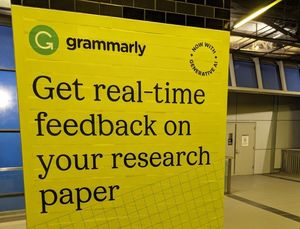I traveled home from the 2nd M-Libraries Conference in UBC, Vancouver, yesterday. I was interested to come across several relevant news stories in the reading materials I had bought en route: The Globe and Mail, The Economist (last week’s, as it turns out), and The Financial Times. This underlined the topicality of the conference themes.
The iPhone was prominent at the conference, in discussion, but also in practice as they were slipped in and out of pockets and bags throughout. In an interesting presentation about their WolfWalk project, Tito Sierra of NCSU opened with some general remarks about geo-location and touch screens as distinctive capacities supporting new applications. He also reminded people of the importance of the Apple Apps store in reducing transaction costs for users: search and acquisition of apps was now straightforward. What Apple has done is to create a network of developers around its successful platform. The App Store is key to this as it allows app developers to find users, and users to find apps, and in the process the value of the iPhone/iTouch is increased. This point was reinforced in a story about Apple’s success in countering the effects of the current downturn in the Financial Times. John Gapper quotes work by Hagel and Seely Brown of Deloitte which shows that lower costs of entry brought about by regulatory and technical trends are creating stronger competitive challenges for companies. Apple’s ability to resist this trend depends on the way in which it has created a platform around which a network of partners has built thousands of apps. So, for the Palm Pre to be successful, for example, it not only has to compete with the iPhone on price and features, but also on its ability to become a platform for app developers. Much of the value of the iPhone now derives from the apps which are available to its users.
I was also struck by the number of Mlib09 delegates who were using netbooks. I suppose you would expect this at such a conference, but this did not make it any less striking. The Economist had an article on netbooks, focusing on their challenge to the computer and software industry generally. They report Gartner figures that 21M netbooks will ship this year, twice as many as last year, accounting for more than 15% of the laptop market. By the end of 2008, netbook pioneer Asus had sold nearly 5M Eees. I was interested to read that Microsoft was heavily discounting Windows XP to netbook providers to counter the Linux challenge. Acer and other firms plan to use Android.
One of the hits of the conference was the discussion by Kate Robinson of the use of QR Codes in the catalog at the University of Bath (blogged here earlier this year). It prompted discussion of the variety of ways in which people and materials could be tied into the network.
The Globe and Mail had several stories about capturing data from codes.
- Databars. A discussion of the use of Databars, smaller than barcodes, in retail and supply-chain operations.
- Samplesaint: a story about how this company, which creates digital media for cell phones, now distributes discount coupons for redemption by on-screen scanning at the checkout. Coupons can be received in various ways, including in response to an on-the-spot request by texting a number found on the relevant shelf.
- There is also a general discussion of the use of cell phones as payment devices.
Interestingly, these were opposite an advert for IBM (featuring a barcode image) which promoted its ability to make supply chains smarter and more efficient.



